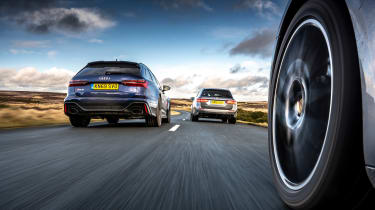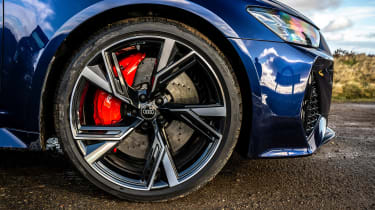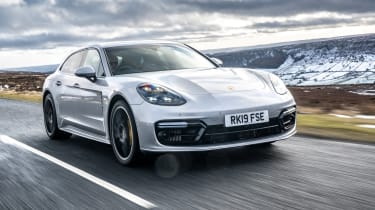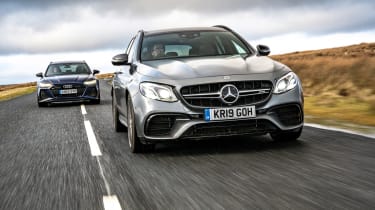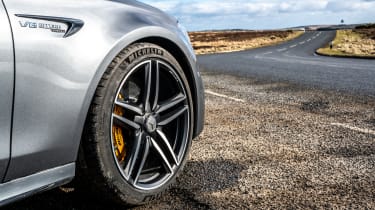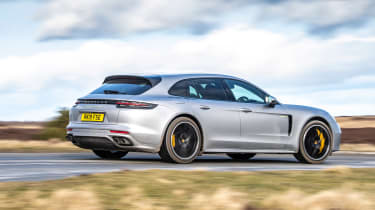Audi RS6 v Porsche Panamera Sport Turismo v Mercedes-AMG E63 S Estate – super-estates go head-to-head
Which 600bhp wagon is the current super-estate king? It‘s time to find out as the Audi RS6 Avant takes on Porsche Panamera Turbo S E-Hybrid Sport Turismo and Mercedes‑AMG E63 S Estate
I get the appeal of SUVs. Who doesn’t like to go upstairs on a double-decker bus and sit at the front? I wouldn’t want to do the Col de Turini in one, though, or hack across the North York Moors. Yet ingenious chassis engineers have managed to coax dynamic ability from tall-built SUVs using clever tech such as active anti-roll bars, and basic engineering such as enormous wheels and tyres.
There’s a place for the multi-purpose SUV of course, it’s the ones that are just jacked up sports saloons that baffle us, especially the ‘coupe’ versions. Compromised dynamics and hopeless space efficiency in a single package. Why would you, when there are cars such as the Mercedes-AMG E63 S, Porsche Panamera Turbo and the new Audi RS6, all available in super practical, super cool five-door estate form?
There’s a clue, maybe, half way up the A1, when we’re overtaken by a BMW X5 M50d that’s being used as a sort of snow plough, encouraging traffic across to the left-hand lane by driving so close that only the twin kidney grille is visible in the rear-view mirror.
> Audi RS6 review - return of the king
Our trio of big German load-luggers all have four-wheel drive and 4-litre, biturbo V8s with about 600bhp, but they’re as different to drive as they are to look at. We’re big fans of the E63 S, which has managed to blend the spirit of its rear-drive predecessor with fantastic traction. The Panamera is shot through with star quality too. We’d have preferred the regular Turbo but none was available, so it’s the E-Hybrid and thus the most powerful car here, with 542bhp from its V8 and 134bhp of electrical drive for a total of 671bhp. The RS6 makes 592bhp and the E63 604bhp. Hardly shabby.
The Panamera churns out a thumping 627lb ft of combined torque too, which you might imagine is also the best here, yet the E63 matches it. The RS6 makes do with a trifling 590lb ft. The downside for the Porsche is that the battery pack and motor add 300kg, and that’s a lot even in a 2000kg supersaloon.
You can get the new RS6 in much bolder colours, including red, but they seem to make the enormous 22-inch Whizzwheels-style alloys (standard on this £101k Launch Edition example) look cartoonish. Dark blue downplays them, and the gaping front grilles, but the RS6 still looks menacing in the rear-view mirror, like something Batman would drive, with its bulky, muscular outline and beady headlamps.
The interior looks expensive, a classy cocktail of black leather, faux carbonfibre, satin chrome and glossy piano black. The last of those matches a centre console and screen with flush, haptic buttons. Thus far, much as expected, then. The difference this time, we are promised, is that the RS6 has nailed the finer points of dynamic deportment.
Before we’ve reached the end of the lumpy driveway from the evo office, it’s clear that the RS6 rides really well. Yes, even on 22s with skinny Pirelli tyres. Then there’s the RS’s secret weapon: four-wheel steering. You can see the rear wheels changing angle swinging around the car park. Once you’re rolling, if you weave the wheel from side to side it feels a bit overeager, but there is, literally, a better test just around the corner.
We are heading for the North York Moors, and the first part of the route chosen by the satnav is on country roads we know well. They’ve undone many a car with their pronounced crowns, crests, dips and patchy surfaces, but the Audi doesn’t even acknowledge many of the challenges. Just as impressively, the roads’ high-hedged, unsighted narrowness means you have to keep tight to your side, so you need a car that is accurate and easy to place. The broad-shouldered RS6 aces it. In fact, after just a mile or so, I’ve forgotten how wide it is and that it has four-wheel steering. Genuinely, this RS6 feels no bigger than an RS4.
Refinement is excellent, too. If anything, the engine is a little too muted, so that at first you’re not sure how many cylinders it’s got. It picks up when you give the throttle a decent squeeze, at which point it’s clear that despite weighing in at just over two tons, almost 600lb ft of torque from 2050rpm gets it moving pretty sharpish. So the RS6 also disguises its weight. Are there any flaws, any chinks in its armour? Well, the HMI isn’t as intuitive now and very occasionally you can feel the mass of one of those 22-inch wheel and tyre assemblies resisting the control of its spring and damper, as you might in an SUV.
Audi RS6 Avant
| Engine | V8, 3996cc, twin-turbo |
| Power | 592bhp @ 6000-6250rpm |
| Torque | 590lb ft @ 2050-4500rpm |
| Weight | 2075kg |
| Power-to-weight | 290bhp/ton |
| 0-62mph | 3.6sec |
| Top speed | 174mph (option) |
| Basic price | £92,750 |
Lime green detailing hints that this Panamera is the E-Hybrid model, and initially it’s a very different experience. Turn it on and a faint electrical hum indicates it’s ready to go. It starts in ‘E’ by default and with a full charge can go for 20 miles or so on electric power before shifting into ‘H’, hybrid mode, the V8 kicking in smoothly. Initial impressions are that the ride is noisy and a bit coarser than the Audi’s, yet that overall ride control is a bit looser too, feeling underdamped at the front. A press of the damper button gives tauter control but with increased road noise.Half an hour up the A1, I swap into the Panamera. While the Audi looks like a car that’s been beefed up, the big Porsche looks wide but flat-sided, like its extra width was added down its centre line. It’s a bit better looking in Sport Turismo form, but even on black 21s with diamond-cut rims, it’s a subtle thing. The Mercedes falls somewhere between the two, its arches distended sweetly, its nose gappy with intakes, but in Salesman Grey – sorry, Selenite Grey – it takes a stock E220d estate alongside to reveal all of the upgrades.
On the plus side, the Panamera’s range of seat adjustment is remarkable, the driver’s seat seeming to go down an extra floor compared with the other pair, and the steering has an on-centre pick-up and precision that the Audi’s lacks. You need to get used to the Porsche ‘sailing’ though. On the motorway, back out of the throttle and the tacho needle drops and there’s no engine braking. This seems to be a strategy to preserve momentum and get the driver to use the brakes; up to a point, retardation is provided by regenerative resistance, feeding energy back into the battery pack.
The Mercedes feels a bit old school after the other pair. It’s a more traditionally shaped estate (and thus the most practical here) and looks and feels somehow narrower (at 1907mm wide it’s 30mm and 44mm slimmer than the Porsche and Audi respectively). It has 4Matic+ all-wheel drive, but it’s the only one here that allows you to select a rear-drive ‘drift’ mode, something I can only imagine the tiniest percentage of owners will ever do. And journalists. It’s really not necessary though, because when shown a decent set of bends, the E63 S reveals that it has a biddable chassis balance and outstanding traction.
This is a relief, because up to this point the E63 has been a little disappointing, being by far the least refined, with strong road noise and a ride in Comfort mode that is both the busiest and the least poised. Switching up to Sport improves things, the ride becoming more consistent and calmer, with no increase in road noise. It should be the default. Sport+ has the nine-speed auto hanging on to high revs and uncorks a rolling thunder soundtrack and overrun crackles and pops. It’s like a classic race V8 has been dropped under the bonnet.
> Porsche Panamera review – verdict, specs and prices> Audi RS6 review - return of the king
Skirting around York, the weather is now dry and bright, but within a few miles of Pickering there is patchy snow on the verges, and the whiteness increases as we head up onto the moors. Happily the roads are mostly dry and the temperature is higher than the view would suggest at around 7deg C. This is a relief because four-wheel drive would be of very limited use without winter tyres.
The E63 feels at home here, its ride calm and flat despite a busy surface, its grip strong and its power energising the driveline so that there’s a satisfying sense that all corners are doing their bit, with just a little more going through the rear tyres. It’s a very fast car. Every now and then you pop over a crest and the road sets off for the horizon some distance away, and if you kept your foot in you wouldn’t run out of shove before you got there. Annoyances remain, though. Who thought a flat-sided steering wheel was a good idea? And why, given the range of tuneables, is steering weight not among them? It’s a little heavy in anything but Comfort.
Corners combined with bumps seem to trouble the Panamera, occasionally inducing an odd, diagonal float, and even in Sport the nose seems to hang over crests too. It certainly has the pace, its instant throttle response with a full charge becoming a relentless push for the red line, unhindered by pauses to change gear. Yet even in Sport+, at its most tied-down, you can’t escape the influence of the extra 300kg, which even corrupts the fidelity of the steering.
In contrast, the RS6 strides across the landscape like it owns it. You can pre-program a pair of set-ups and access them via the ‘RS’ button on the steering wheel, and with everything set to its sportiest you can feel the car lower on its air springs. This doesn’t seem to compromise its ride, so the RS6’s dynamic character is helpfully consistent across all modes. It’s planted and confident, soaking up lumps and bumps without deflection, its steering accurate. In common with its rivals, it’s only when the RS6 tackles a sharp crest that the amount of metal in motion is fully revealed, though unlike the E63, the RS resists the feeling that the front struts have run out of travel.
It’s been a day of revelations, most of them surrounding the Audi. ‘That traditional nose-heavy cornering stance is all but eradicated, making this not only the most agile RS6 but the most agile Audi Sport model this side of an R8,’ says editor Stuart Gallagher. ‘The rear-steer helps transform it from a point-and-squirt machine into a genuine driver’s car.’
Antony Ingram, who has driven the RS6 before in Germany, agrees. ‘Four-wheel steering is the killer app. You can trust that the nose will go where you point it but also that the tail won’t do anything silly, and that makes it such a great point-to-point car even on wet or greasy surfaces.’
We’re warming to the Mercedes. Dynamically, it’s not instantly gratifying, but put it to work and it starts to shine. ‘The quicker you go, the more the car comes to you,’ says Gallagher. ‘The steering delivers more feel, the ride finds a balanced fluency and that V8 proves the most charismatic and exciting here.’ Ingram agrees: ‘It’s an absolute cracker! Less cultured than the others and all the better for it. Subjectively the AMG feels faster I reckon, simply because you get a bit more noise and a bit more energy fizzing through the car. The Porsche is very slick and the Audi so competent that using all its power feels quite natural, but the Merc maintains that slightly unhinged feeling of its predecessors…’
Mercedes-AMG E63 S 4Matic+ Estate
| Engine | V8, 3982cc, twin-turbo |
| Power | 604bhp @ 5750-6500rpm |
| Torque | 627lb ft @ 2500-4500rpm |
| Weight | 1995kg |
| Power-to-weight | 308bhp/ton |
| 0-62mph | 3.5sec |
| Top speed | 186mph |
| Basic price | £96,780 |
Not a description you could level at the Porsche. It can feel just as fast as the others but it never feels as tied down and focused. ‘The three-chamber air suspension feels too clever for its own good, trying to second-guess what’s happening rather than reacting to the situation,’ says Gallagher. ‘The knock-on effect is a lack of confidence. You don’t commit because there’s a nagging doubt the Panamera isn’t going to do what you want.’
Ingram isn’t getting on with the Porsche’s ‘sailing’. ‘It drives me nuts! Unless you’re in Sport or Sport+ at high revs, the lack of engine braking or regen is quite disconcerting in something that feels so big and heavy. You’re forced to use the brakes more, and Porsche hasn’t quite nailed the blending of regen and friction brakes.’
Early next morning, I start off in The Porsche. The pristine sky is just starting to brighten, and although the Panamera arrived last night with minimal electrical power and didn’t get plugged in, it manages to defrost the screen and warm the driver’s seat, steering wheel and interior without firing the engine. Only as I select drive does the V8 kick in, quietly.
The twisting coastal road from Whitby to Scarborough gives the Panamera another chance to impress, and it does. It has fine steering, connected, feelsome and accurate through the slim, round rim. But as the pace picks up and the road gets twistier, the ride starts to feel less composed, the mass less controlled. Firming the dampers helps, but you have to wonder whether the hybridisation is worth it.
The proposition itself seems a little absurd: a two-ton-plus, 671bhp, 192mph five-door with 300kg of hybrid kit. Fuel economy and CO2 figures should correlate, but the Porsche’s 76g/km rating did not result in it being three times more economical than the Mercedes (246g/km). All three were helped by our steady run up here, the Porsche returning 33mpg, the Mercedes 27mpg and the Audi (least fancied on 263g/km) managing 30mpg.
The Audi and Mercedes have their own fuel-saving strategies, the RS6 having a separate 48V electrical circuit that charges up under mild braking. It also prompts the driver with a little pulse of the throttle to lift off approaching junctions and lower speed limits. The Mercedes, meanwhile, becomes a ‘four’ on a light throttle. Even so, it will come as no surprise that if you’re really enjoying them, all three will drop into the low 20s… or even the mid-teens.
> Mercedes-AMG E63 S review – verdict, specs and prices
Unexpectedly, the Porsche reveals some of the old Stuttgart magic in the corners. With cars such as these, it’s not so much about hanging the tail out as finding a satisfying balance, one that might be exploited. And despite the extra mass (2325kg to the Audi’s 2075kg and Merc’s 1995kg), the Panamera is predictable and adjustable. In Hybrid mode it turns keenly but is balanced, safe. In Sport there’s more drive to the rear, so you can balance the car, and in Sport+ a little twist of oversteer (or more) is there for the taking, the car composed, calm and transparent. The Audi takes its driver on the same journey, the difference being that when really pushing on you can still feel that it’s a nose-heavy car. Ask for a slug of power mid-turn in Comfort and the front will edge wide like a big hot hatch. Cycle up the modes and you can feel the drivetrain bringing the rear axle increasingly into play, and although it’s effective and exploitable, the Panamera remains more natural and nuanced.
Porsche Panamera Turbo S E-Hybrid Sport Turismo
| Engine | V8, 3996cc, twin-turbo, plus 100kW electric motor |
| Power | 671bhp (combined) |
| Torque | 627lb ft (combined) |
| Weight | 2325kg |
| Power-to-weight | 293bhp/ton |
| 0-62mph | 3.4sec |
| Top speed | 192mph |
| Basic price | £142,279 |
The E63 seems initially to sit somewhere between the two: less compromised than the RS6, but not quite as fluent as the Panamera. Hustle the E63 and it can feel like the old rear-drive car is lurking just below the surface, but if it feels like that, you’re not driving to its strengths. Dive into a series of bends letting the front get almost to each apex before gassing it and then the grip will impress and the traction will astound you. In these moments the E63 feels more like an Impreza STI than a two-ton, five-metre estate.
‘Before this test, the E63 S was my favourite,’ says Gallagher, ‘and it’s still the purest to drive when you’re able to enjoy all of its performance. The Panamera is a bit frustrating because you know there’s a good car in there. And the RS6? It was an icon that rarely delivered dynamically but had a cult car appeal…’
Well, the RS6 delivers now. Yes, the E63 can conjure up moments of dynamic brilliance to outshine the RS6, and the Panamera has the best steering, but they have both spent most of this contest coming from behind. ‘All three make you question why you’d ever need a performance SUV,’ says Gallagher, ‘but Audi has retained all the RS6’s cult car appeal while adding an unprecedented level of driver appeal. It finally delivers on its promises with no excuses.’
Moments of cornering joy make up a small part of the repertoire of the super-estate. Audi has moved the game on where it matters and moved it on significantly. This is a different kind of RS6.
‘I really admire the work Audi has done behind the scenes to turn a car whose shtick was straight-line speed and all-weather security into a car that’s engaging to drive,’ says Ingram. ‘The RS6 feels much lighter and more agile than you’d infer from its size and weight. It’s genuinely good fun.’
It demonstrates real flair where before there has been little. It’s on the biggest wheels here but has the best ride and composure, integrates four-wheel steer almost imperceptibly, feeling naturally agile and responsive right away, and it’s superbly refined, too. In the RS6 you don’t have to go looking for the magic, it’s right there, ready to be enjoyed from the get-go.
It’s the new King of the Hill, close to being the perfect all-purpose, all-duty, go anywhere super-estate. A car properly deserving of the description ‘sports utility vehicle’.


